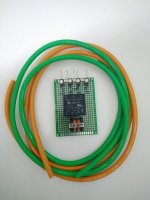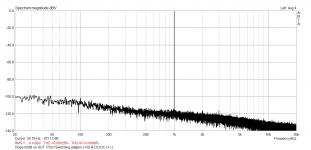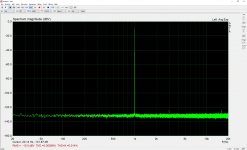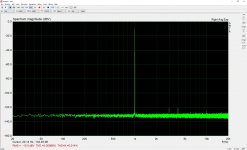Salas, got my 10k TKD pot installed. Used a 3.01k resistor, didn’t have any 2.2k. Overall impressions? I once described this preamp as a “ window on the world”, well somebody just found the windex ! Blacker backgrounds, smoother, but the bass, clean, airy, articulate and musical all the way down to dc. THE best bass I have ever heard in my 67 years on the planet. My hat is off to you Salas ! Bravo ! I have different bc327-40 to try next, will check back in later. Mark
Congratulations. You are welcome.
I did find out that this is all in my analyzer setup cables. Salas mentioned that once when we discussed cheap RCA to TRS adapters. Tried several other homemade cables with these cheap ¼ TRS adapters with mostly same results. Some are more noisy than the others, but all have same picks at the same exact points as on my image during loop test.
Besides good termination contacts, when there is interference star quad is best. But it has double the capacitance.
Star-quad microphone cable demonstration
This is the cable from the video. Canare L-4E6ES. I mainly use it for umbilical between PSU and MC phono boxes. For signal at home its better to avoid the highly capacitive star quad cables if there is not a specific interference source crossing the interconnections that you can hear with normal ones.
In the photo there is also a switching DC to DC bipolar converter board I once made. I used it for powering a differential input chip phono I designed for lab play. In collaboration with a plug style switching adapter so it could be remotely placed on the wall. Thus no transformer and no AC power cabling near the audio circuit.
Goal was to avoid any mains related magnetic field interference around such a high gain & low input signal circuit with the least of expenditure and space.
And I did. No hum spikes for 62dB 1kHz gain. But there was a gotcha. The SMPS noise generated beyond the audio spectrum came back integrated and more than doubled the audible hiss. Weak sound in lower frequencies too. Fail.
Just like when you don't use the 20MHz limit button on a few hundred MHz scope and its line is fatter than a slower cheaper scope. Because noise appears over bandwidth and comes back integrated as a total mV number. The wider the bandwidth the more there is. It can be low per Hz but when the Hz are many it adds up.
Moral of the story is you win some you lose some. Something working great in a specific area isn't necessarily great in all areas.
*Because of RIAA curve there is 40dB gain difference from 20Hz-20kHz. As reflected in the plot's grass tilt. So hum frequencies are even more promoted to be picked in a phono.
*I used UBiB in the end to avoid the hiss and the weak SQ.
In the photo there is also a switching DC to DC bipolar converter board I once made. I used it for powering a differential input chip phono I designed for lab play. In collaboration with a plug style switching adapter so it could be remotely placed on the wall. Thus no transformer and no AC power cabling near the audio circuit.
Goal was to avoid any mains related magnetic field interference around such a high gain & low input signal circuit with the least of expenditure and space.
And I did. No hum spikes for 62dB 1kHz gain. But there was a gotcha. The SMPS noise generated beyond the audio spectrum came back integrated and more than doubled the audible hiss. Weak sound in lower frequencies too. Fail.
Just like when you don't use the 20MHz limit button on a few hundred MHz scope and its line is fatter than a slower cheaper scope. Because noise appears over bandwidth and comes back integrated as a total mV number. The wider the bandwidth the more there is. It can be low per Hz but when the Hz are many it adds up.
Moral of the story is you win some you lose some. Something working great in a specific area isn't necessarily great in all areas.
*Because of RIAA curve there is 40dB gain difference from 20Hz-20kHz. As reflected in the plot's grass tilt. So hum frequencies are even more promoted to be picked in a phono.
*I used UBiB in the end to avoid the hiss and the weak SQ.
Attachments
Yes, but you have to experiment on a breadboard first. You got to find R1 value that drops those averagely high IDSS JFETs down to 5mA. Like in post #452 but with 10VDC. You may also differentiate R1 for individual J113s if you don't have four with same mA result for same R1.
Canare L-4E6ES.
I used it for powering a differential input chip phono I designed for lab play.
*I used UBiB in the end to avoid the hiss and the weak SQ.
Sorry for deviation from the main subject of that thread, but it is very interesting presentation on YouTube and useful info. Thank you for that link. I also use umbilical cord made of quad star cable on my 2 FSP phonos, but I use industrial type Belden made (# 1172A B591000) cable. I did not get an issues with 60Hz magnetic pickup on my phonos yet (I did not measured..
Very interesting DC-DC device to isolate magnetic pickup, but it is 24V out with CT and probably impossible to use it on our FSP running 50V.
It might be possible to use +24V and -24V and let it to float?
My just arrived Mogami cables are quite and I see no picks at low frequencies at all. Totally flat there and I’ll attache ARTA images soon.
About my 2nd just upgraded with Khozmo DCG3, I’m planing long listening session during coming weekend and some “golden ear” friends will come.
So, lets see what would be the impression and consensus, if any….
P.S. As far as I remember, it was an attempt to change regulator on FSP PCB for UBIB. Is it still in plan-list?
Last edited:
Use RF bead or 1uH mini coil in the signal entry point of the phono board to try kill AM. The tonearm maybe needs chassis GND could be a reason.
Don't use SMPS in a phono, the example was to show you may avoid hum field with such when no AC cables are around too but their hundreds kHz switching noise can come back as hiss especially in high gain circuits. Because SMPS small hum field benefit was mentioned in the video. Then again all the adapters he used to demonstrate strong interference were SMPS too. There could be very good ones well filtered and screened suited for line level. Like the one in the pro DAC he showed.
Still enough people tend to prefer L-Adapter linear stabilizer for instance when replacing SMPS bricks even in non interference problematic gear anyway.
That DC/DC in my example came handy to convert a single rail SMPS adapter in a specific situation. Wouldn't be there if the wall adapter was delivering +/- to start with. There is variety.
Nice that you solved the hum susceptible test cables problem.
P.S. Not only that but also trying to make sensitivity selection easier with DIP switches than configuring it by changing some parts. Its under development. A phono only test board is ready for now so to can connect it with regular UBiB and see how they behave together.
Don't use SMPS in a phono, the example was to show you may avoid hum field with such when no AC cables are around too but their hundreds kHz switching noise can come back as hiss especially in high gain circuits. Because SMPS small hum field benefit was mentioned in the video. Then again all the adapters he used to demonstrate strong interference were SMPS too. There could be very good ones well filtered and screened suited for line level. Like the one in the pro DAC he showed.
Still enough people tend to prefer L-Adapter linear stabilizer for instance when replacing SMPS bricks even in non interference problematic gear anyway.
That DC/DC in my example came handy to convert a single rail SMPS adapter in a specific situation. Wouldn't be there if the wall adapter was delivering +/- to start with. There is variety.
Nice that you solved the hum susceptible test cables problem.
P.S. Not only that but also trying to make sensitivity selection easier with DIP switches than configuring it by changing some parts. Its under development. A phono only test board is ready for now so to can connect it with regular UBiB and see how they behave together.
Yes, and you should remember my case when I used your and AndrewT’s advises. I set 3 loops of this cable around quite large locking ferrite bid close to FSP's input RCAs. Two loops wasn’t enough since I still caught some cracklings. My tonearm body is grounded to FSP's signal GND. Not that I have some problem right now, but I think and probably that Cardas cable is not suitable for that purpose. It must be used on tonearms internally only. It is 33AWG with 4 (very tiny) wires and run them about 1 meter long…
Ah, now I got the purpose on that DC2DC.
Please see my test results with new cables attached.
P.S. It is an excited news about new FSP. What is aprox. ETA for these new PCBs?
Ah, now I got the purpose on that DC2DC.
Please see my test results with new cables attached.
P.S. It is an excited news about new FSP. What is aprox. ETA for these new PCBs?
Attachments
Last edited:
Congrats for cleaning your loop. Now you will know your DUT's own harmonic noise spikes with certainty. The interface's own THD, SNR, crosstalk etc. are not that stellar to can see some very linear DUT's pure performance but still very useful. Ap would be out of business otherwise.
P.S. About more phono stuff better in the FSP thread.
P.S. About more phono stuff better in the FSP thread.
Congrats for cleaning your loop. Now you will know your DUT's own harmonic noise spikes with certainty. The interface's own THD, SNR, crosstalk etc. are not that stellar to can see some very linear DUT's pure performance but still very useful. Ap would be out of business otherwise.
P.S. About more phono stuff better in the FSP thread.
Hey Salas,
Your teasing me.
How about a link to the FSP thread?
Rush
Ok then, I know that thread, built two of those.
What the heck does FSP stand for?
Rush
I kind of surprised too and see no change between Focusrite 2nd gen. vs. 3rd one. They claimed that 3rd has a way better spec and noise floor is below 140dB. Maybe I’m not doing right measurement setup, but I do not see that improvement.
I calibrated ARTA and 10dBV is set it to about 130dB scale, same as I saw on my 2nd gen unit. Driver and device utility is nice, but I got no complaints about 2nd get unit on Win 10 without that utility. Marketing lesson...
I calibrated ARTA and 10dBV is set it to about 130dB scale, same as I saw on my 2nd gen unit. Driver and device utility is nice, but I got no complaints about 2nd get unit on Win 10 without that utility. Marketing lesson...
- Home
- Source & Line
- Analog Line Level
- Salas DCG3 preamp (line & headphone)



